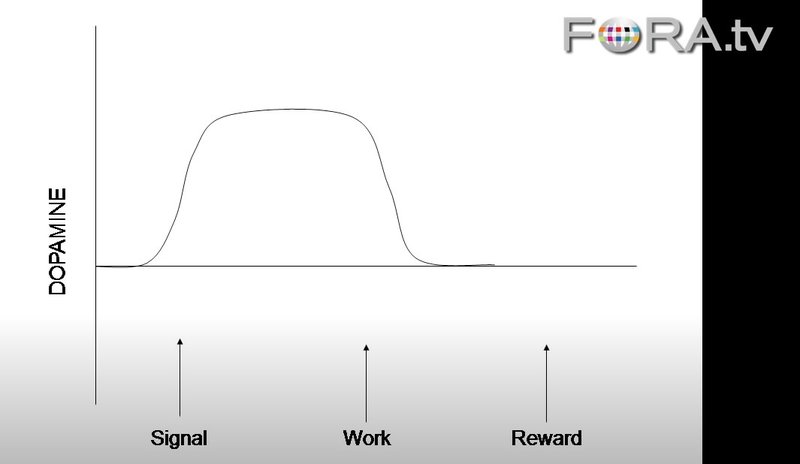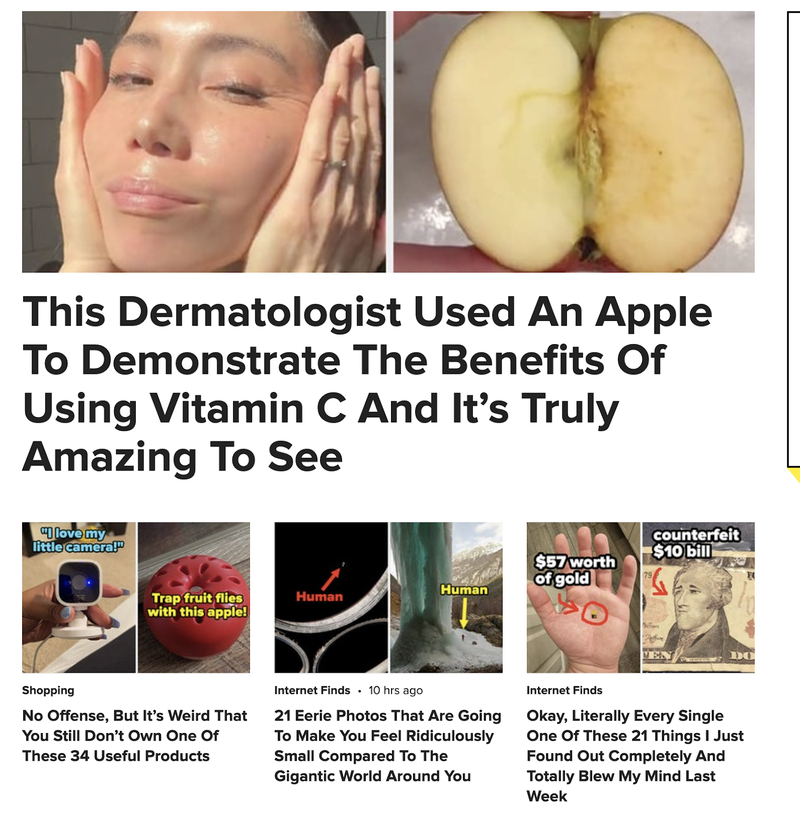Clickbait
- Clickbait
- Clickbait is online material, like an article or video, titled in a way to encourage people to click a link.
This lesson starts off with a section of theory focusing on why clickbait is so widely used and delves into the psychology of convincing your brain to click a link. Students are then challenged to come up with their own clickbait in a creative exercise.
Lesson goals
- Learning about clickbait and the psychology behind it
- Creating clickbait headlines to learn to understand and recognise it
Activities
Theory (10 minutes) - Teacher-centered
Give the students the introduction to clickbait, the psychology behind it, and the ingredients to create a “clickbaity” headline.
Aim: Students learn why and how clickbait is used.
Example (5 minutes) - Teacher-centered
Visit BuzzFeed, or use the screenshot, to analyze some examples of clickbaity headlines using the discussed theory.
Aim: Students learn how the discussed theory is used in practice
Exercise (10 minutes) - Individual work
Challenge students to come up with the concept of a clickbaity article and a headline. Students don’t need to write the article. They only have to describe the idea behind it, write a headline, and make it as clickbaity as possible using the tips and tricks from the introduction.
Aim: Students put themselves in the shoes of a clickbait writer and use the theory in a creative way.
Discussion (10 minutes) - Smaller groups of 3-4 students
Students present and discuss their concepts in groups of 3-4. Every group will pick one headline to share with the class.
Aim: Students present their work and critically assess their peers' work.
Presenting (10 minutes) - Class
Every group presents its chosen concept to the class and students are asked to highlight unique characteristics. Finish the exercise by asking the class to “vote” by a show of hands on which article they would most likely click.
Aim: Students present their work and critically assess their peers’ work.
Discuss some discussion questions with the students.
Aim: Students learn additional information about clickbait.
Pedagogical tips and recommendations
- Open up the homepage of Buzzfeed or Upworthy for some extra examples.
Theory (10 minutes)
Internet traffic
In a period when the internet got busier and busier, online media figured they would have to come up with new ways to outsmart their competition.
How do people choose the next YouTube video to watch out of nine recommendations? They pick the video whose thumbnail and headline pique their curiosity the most. Online content needs to stand out in order to convince people to engage with it. The number of people that watch your video or read your article are referred to as “internet traffic”.
Internet traffic is worth a lot of money, because it allows media companies to show advertisements and boast higher numbers to future advertisers and sponsors. In other words: every time you show somebody an ad, you can make a bit of money. The more ads you show, the more money you make, and the more other companies will want to advertise on your platform.
Apart from bumping up the value of ads, increased traffic also puts a webpage in the good graces of search engine algorithms like Google. If a page receives plenty of high-quality traffic, Google Bot “thinks” the page is of value to people and will rank it higher in the search results.
Why clickbait works
Clickbait tries to redirect as much internet traffic as possible to wherever the link goes. Like a fishing lure, it wants to attract your attention to reel you in. Different media and companies desperately want your attention and try to appear more interesting, newsworthy, or edgy than the rest.
One reason we find it hard to resist clickbait is that humans are hardwired to look for information. Walk into an empty room with a closed cardboard box in the middle. Is it a snake or a birthday cake? You want to open the box to find out, right?
Behind our curiosity lies a state of anticipation caused by dopamine—also called “the happy hormone”—potentially leading to a future reward, like food or information. In this video, Stanford neuroscientist Robert Sapolsky explains this process as follows: "Dopamine is not about pleasure; it's about the anticipation of pleasure. It's about the pursuit of happiness rather than happiness itself."

Clickbait gets us going by making us anticipate something positive, releasing hormones that make us feel good. The rush you feel motivates you to go get that reward. And in the case of clickbait, all you have to do to fulfil your curiosity is to click that link. It’s that easy! You might see the cutest crocodile in the world without the risk of getting bitten.
How clickbait works
A good clickbait title creates an information gap. When humans perceive an information gap, all systems go to fill the void. The title “These Five Baby Animals Will Make You Fall In Love” makes you wonder: what baby animals can this possibly be about? How cute can they be? It also tells that you will have an extraordinary experience when you see them: you will fall in love! Then, it promises to answer all of your questions if you just follow the link, potentially leading you to the baby croc photos you were hoping for.
Numbers and lists also put our senses on high alert. They lay out the text in an organized fashion and tell us in advance how long it will be (“5 Places You Need To See Before You Die”), which gives readers an idea of how long it will take to read.
A clickbaity “listicle” (an article written in the format of a list) does not only promise a reward, but also makes it super easy to get it. Like knowing how long it takes to walk from A to B—will it be 15 minutes or 1.5 hours?—humans prefer to know where they stand before they commit to something.
You Won’t Believe These Mind-Blowing Clickbait Writing Tips
- Create a knowledge gap
- A title like “This Mysterious Disappearance Remained Unsolved Until a Computer Scientist Got Involved” will make you wonder what happened. The only way to find out is by clicking the link and reading the piece.
- Promise an incredible experience
- Like the title of this section, “You Won’t Believe These Mind-Blowing Clickbait Writing Tips”, a clickbait title may promise a “mind-blowing” experience. This makes the information seem more valuable: who doesn’t want their mind to be blown? Not clicking makes you feel like you are missing out on a great experience.
- Use numbers and lists
- Make it easy for prospective readers to understand what you’re offering (and how amazing it is). “Cool Islands” as a headline simply doesn’t have the same ring as “Three Islands to Visit Before You Die”.
Here are some prompts to help students if they are having difficulty thinking of their own:
- You'll Never Believe X
- X Things You Need to Know
- This Is What Happens if You X
- The X Best
- X Places You Need to See Before You Die
Example (5 minutes)
Visit BuzzFeed, or use the screenshot, to analyze some examples of clickbaity headlines using the discussed theory.
Example of clickbait headlines on BuzzFeed.com, retrieved on 16 August 2022:

Other examples from the media:
- The mystery of the lost Roman herb (BBC)
- Nearly a third of baby foods sold in UK are ultra-processed, research finds (The Guardian)
- This Italian region is turning away tourists, and Cornwall could be next (The Telegraph)
For examples of some clear titles that are not clickbaity, check out Deutsche Welle in English.
Exercise (10 minutes)
Students write a clickbaity headline using the tips and tricks from the introduction. Their headlines will then be presented and given feedback in smaller groups. A selection will be highlighted and discussed with the class.
Exercise
- Students will individually write the concept of a clickbaity article and a headline, consisting of:
- A headline (title) for the article using tips and tricks from the introduction.
- The concept of the article (“an article about the best parks in Ljubljana”).
Discussion (10 minutes)
- Divide the class into groups of 3-4 students.
- Students present their concepts to each other in groups of 3-4, and give each other feedback.
- Every group will pick one article concept and headline to share with the class.
Presenting (10 minutes)
- The highlighted examples from each group are discussed with the class.
- Students “vote” by a show of hands on which clickbaity title they would click.
Discussion (Optional)
- Is clickbait a good or bad practice in media?
- What is the difference between clickbait articles and “traditional news”?
- Does clickbait stand in the way of a healthy media diet? If so, how?
- How would you try to reach an audience without using clickbait?
- How could fake news help to make an article more clickbaity?